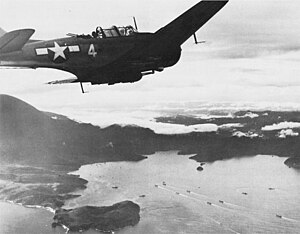| Battle of Hollandia | |||||||
|---|---|---|---|---|---|---|---|
| Part of the New Guinea Campaign | |||||||
 Landing craft approaching Tanahmerah Bay | |||||||
| |||||||
| Belligerents | |||||||
|
|
| ||||||
| Commanders and leaders | |||||||
|
|
| ||||||
| Units involved | |||||||
|
|
| ||||||
| Strength | |||||||
| ~ 30,000 | 11,000 | ||||||
| Casualties and losses | |||||||
|
152 killed 1,057 wounded |
3,300 killed 300 captured | ||||||
The Battle of Hollandia (code-named Operation Reckless) was an engagement between Allies of World War II and Japanese forces during World War II. The majority of the Allied force was provided by the United States, with the bulk of two United States Army infantry divisions being committed on the ground. Air and naval support consisted largely of U.S. assets, although Australia also provided air support during preliminary operations and a naval bombardment force.
The battle took place between 22 April and 6 June 1944 and formed part of the New Guinea campaign. The operation consisted of two landings, one at Tanahmerah Bay and the other at Humboldt Bay, near Hollandia. The landings were undertaken simultaneously with the amphibious invasion of Aitape ("Operation Persecution") to the east. The battle was an unqualified success for the Allied forces, resulting in a withdrawal by the Japanese to a new strategic defense line in the west of New Guinea and the abandonment of all positions in the east of the island.